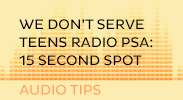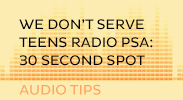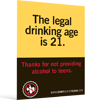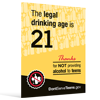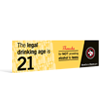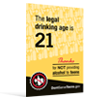Please download and share our resources.
Announcer copy
15 seconds
You know the legal drinking age is 21. You may also know this law protects teens. Find out more at DontServeTeens.gov. And thanks for not providing alcohol to teens. A message from [local organization] and [station call letters].
Did you know? 70 percent of teens who drink get alcohol from family and friends. Thanks for not providing alcohol to teens. Find out more at DontServeTeens.gov. This message is from [local organization] and [station call letters].
20 seconds
Did you know? Most teen drinking-related deaths are not from traffic accidents. Instead, they’re from alcohol-influenced homicide, suicide, poisoning, burns, drowning, and falls. Visit DontServeTeens.gov for more information. A message from [local organization], and this station.
Did you know? In one recent year, almost 40,000 kids were admitted to a hospital with alcohol problems. The average stay was 5 days and cost $19,000. Don’t provide alcohol to teens. Visit DontServeTeens.gov for more information. A message from [local organization] and this station.
Op Ed page
Send the op-ed below to your local newspaper's editorial page staff. Ask them to print it when appropriate. Find newspaper contacts on the paper’s website. No circulation is too small.
Underage drinking is a persistent problem that deserves increased attention. The legal drinking age is 21, and it is a law that protects teens. Most teen alcohol-related deaths are not due to traffic accidents, but from homicide, suicide, poisoning, burns, and drowning. Plus, about 180,000 kids visit the ER each year because of problems related to alcohol. So “taking away the keys” is not the answer, and turning a blind eye to teen drinking can contribute to harm. Most teens who drink get their alcohol from “social” sources – from friends or family, or by taking it from a home. That’s why it is important to focus on stopping these sources of easy access. DontServeTeens.gov is an FTC-led campaign to reduce underage drinking, providing information in English and Spanish about the rates and risks of teen drinking, links to state alcohol laws, tips on how to talk to friends and neighbors about serving alcohol to teens, and free downloadable artwork and media materials that organizations can use in their communities. Visit DontServeTeens.gov for more information.
Press release
Cut and paste this press release into your organization’s letterhead, double-spaced. If it runs more than two pages, consider using a smaller typeface or line-and-one-half spacing, or edit the text.
FOR IMMEDIATE RELEASE: [Insert date]
CONTACT: [Insert name, phone number]NATIONAL CAMPAIGN TARGETS EASY TEEN ACCESS TO ALCOHOL
Don’t serve alcohol to teens. It’s unsafe, illegal, and irresponsible.As teens around the country return to school [OR, begin prom season, OR, start summer vacation], the national We Don’t Serve Teens program is once again targeting teens’ easy access to alcohol. Over the past two decades – following adoption of the legal drinking age of 21 – drinking by high school seniors has dropped substantially. It’s a law that protects kids.
Too many teens still drink, though. Where do they get the alcohol? A U.S. government survey shows that most of them do not pay for it. Instead, they get it from family and friends, or they take it from a home without permission.
“Most alcohol-related deaths among teens are not due to traffic accidents, but to homicide, suicide, poisoning, burns, and drowning. Plus, about 180,000 kids visit the ER each year due to alcohol-related problems.” said [your organization's spokesperson and title]. “So turning a blind eye to teen drinking contributes to harm.” [name] added, “If you need to know how to answer questions about underage drinking, visit DontServeTeens.gov for information.”
The Don’t Serve Teens campaign, led by the FTC, the nation’s consumer protection agency, is supported by [your organization] and has been recognized by the U.S. House and Senate. Visit DontServeTeens.gov for more information.
Letter to the editor
Cut and paste this Letter to the Editor into your organization’s letterhead, and have it signed by your organization's president. Send it to local newspapers, community newsletters, websites, and bloggers.
Dear [editor's name]:
Underage drinking is a persistent problem that deserves our attention. The legal drinking age in the United States is 21. Underage drinking can cause serious health and safety consequences. For example, recent data show that most teens alcohol-related deaths are not due to traffic accidents, but from homicide, suicide, poisoning, burns, and drowning. Plus, about 180,000 kids visit the ER each year due to alcohol-related problems.
Most teens who drink get their alcohol from “social” sources – friends and family, or by taking it from a home. “We Don’t Serve Teens,” an FTC-led campaign to reduce underage drinking, focuses on the social sources that provide easy teen access to alcohol. The campaign website, DontServeTeens.gov, has information in English and Spanish about the rates and risks of teen drinking, links to state alcohol laws, tips on what to say to friends and neighbors about serving alcohol to teens, and free downloadable artwork and media materials that organizations can use in their communities.
[Organization] supports the DontServeTeens program. We believe that it is critical to protect our most precious national commodity by reducing easy access to alcohol. Please don’t serve alcohol to teens, and ask others not to either.
Sincerely,
[your name and organization]
Newspaper Column
TEENS AND ALCOHOL
The We Don’t Serve Teens program, a Federal Trade Commission-led program targeting underage drinking, has revamped the DontServeTeens.gov site to reflect the newest research on teen drinking. “About 180,000 kids ages 15-20 visit an emergency room each year due to alcohol-related problems,” said Mary Engle, Assistant Director of the FTC’s Division of Advertising Practices. “Most teen alcohol-related deaths are not due to traffic accidents, but to homicide, suicide, poisoning, burns, and drowning,” she added, “so taking away their car keys and letting them drink is simply not a good solution.” Engle states that the key to reducing teen drinking problems is reducing teens’ easy access to alcohol, because most teens who drink get their alcohol from older friends and family, or by taking it from a home without permission. DontServeTeens.gov, available in both English and Spanish, provides data on the rates and risks of teen drinking, tips on what to do and say to reduce teen access to alcohol, and free downloadable campaign materials including posters, PSAs, and web buttons and banners. It recommends that parents keep track of alcohol at home and speak up when underage drinking is discussed.
“Be frank and tell other parents that you don’t want them serving alcohol to your teen or condoning teen drinking,” says Engle. “And talk to adults who host teen parties. Let them know that it is not OK to serve alcohol to someone else’s kid.”
Public service announcement for radio
Downloadable art
Logo
Download WDST-logo.png
Download WDST-logo.tif
Print Ad
Download WDST-12x9.5.psd
Download WDST-12x9.5.jpg
Posters
Billboard
Bus Shelter
Transit Ads
See a PDF Preview
Download a zip file with 8 transit ads including bus side ads, bus shelters, and metro ads: WDST-transitads.zip

